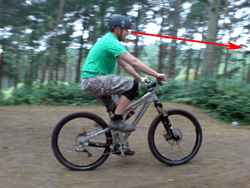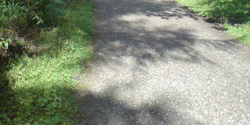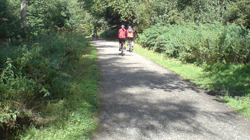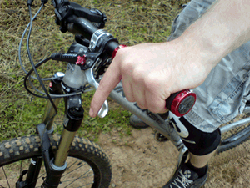|
 |
 Beginners
The 5 basic riding skills allow you to spot potential problems on the trail early and give you time to deal with them effectively. They are the core skills that will keep you safe and significantly reduce the risk of injury when out on the trail. Look well ahead.
By looking ahead you will be able to plan early and avoid panic braking or jerky steering which can lead to your wheels skidding causing a crash.
The second image on the right shows know what you are riding over. Luckily it is pretty smooth.
The next image shows that by looking up, you are alerted to potential hazards far earlier. Notice how the riders ahead have easily moved over to the right hand side of the trail to avoid a large pool of water.
Look for potholes, puddles, loose gravel, wet roots or anything else that you want to avoid.
The faster you go the more time it takes to slow down so you need to look even further down the trail.
Spot the problems.
Once you spot a hazard don't stare at it or that is where you will end up, deal with it by changeing course to a smoother section of trail then continue scanning the trail further ahead for problems. Look for the good part of the trail which you will ride over.
Move your eyes.
Try to alternate where you look between just in front of you and at least a bus length up the track to check you are on the right line.
A second glance at the trail as it gets closer will make sure you are on the correct line and give you a chance to spot anything you missed the first time.
Look at the side of the trail for any logs or ditches that may cause problems as well as the center section.
Be prepared.
Dont assume the trail ahead is safe if you can't see it. be prepared to stop in the distance you can see to be clear.
Around that blind corner there may be a section of trail beyond your ability, an injured rider lying in the trail or a group of walkers.
Plan well in advance.
Planning well in advance will allow you to brake or change direction well before an obsticle. Brake or steer early and smoothly rather than leaving it to the last minute.
Keep your brakes covered at all times, this will greatly reduce your braking response time.
    |
top | home | beginners | fundamentals | advanced | downhill | resources
Copyright ©2009 MTB Techniques | All rights reserved
The information on this site should be taken as a broad guide only and is open to interpretation and misunderstanding. You should consult a qualified instructor for more information about any of the tips given. MTB Techniques cannot accept responsibility or liability for accuracy, clarity or your interpretation of any of the topics provided. Mountain biking can be dangerous. You must make sure you understand the level of risk involved and wear suitable protective equipment whenever you ride.